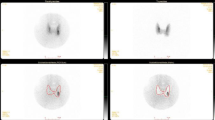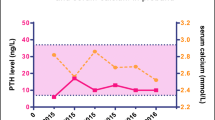Abstract
We describe the clinical and genetic findings in pedigree with a novel mutation in the calcium sensing receptor (CaSR) gene and the unusual coexistence of primary hyperparathyroidism (HPT) and familial hypocalciuric hypercalcaemia (FHH) and its clinical management. The occurrence of both FHH and primary HPT in the same patient has been described rarely. Our pedigree has a novel mutation in the CaSR gene. Parathyroidectomy led to a reduction, but not normalization of the calcium levels in the patient identified as having HPT. The coexistence of HPT and FHH was considered in this patient as her calcium and PTH levels were rising with time. Surgical resection of her parathyroid adenoma resulted in reduction of her calcium levels to above normal and significant reduction in her symptoms of fatigue and low mood.


Similar content being viewed by others
References
Thakker RV (2004) Diseases associated with the extracellular calcium-sensing receptor. Cell Calcium 35:275–282
Carmliet G, Cromphat SV, Daci E, Maes C, Bouillon R (2003) Disorders of calcium homeostasis. Best Pract Res Clin Endocrinol Metab 17:529–546
Brown EM (1983) Four-parameter model of the sigmoidal relationship between parathyroid hormone release and extracellular calcium concentration in normal and abnormal parathyroid tissue. J Clin Endocrinol Metab 56:572–581
D’Souza-Li L, Yang B, Canaff L, Vai M, Hanley DA, Bastepe M, Salisbury SR, Brown EM, Cole DEC, Hendy GN (2002) Identification and functional characterisation of novel calcium-sensing receptor mutations in familial hypocalciuric hypercalcaemia and autosomal dominant hypocalcaemia. J Clin Endocrinol Metab 87:1309–1318
Pollak MR, Brown EM, Chou YH, Hebert SC, Marx SJ, Steinmann B, Levi T, Seidman CE, Seidman JG (1993) Mutations in the human Ca2+-sensing receptor gene cause familial hypocalciuric hypercalcemia and neonatal severe hyperparathyroidism. Cell 75:1297–1303
Bouschet T, Martin S, Henley JM (2008) Regulation of calcium-sensing-receptor trafficking and cell-surface expression by GPCRs and RAMPs. Trends Pharmacol Sci 29:633–639
Eldeiry LS, Ruan DT, Brown EM, Gaglia JL, Garber JR (2012) Primary hyperparathyroidism and FHH: relationships and Clinical implications. Endocr Pract 18:412–417
Burski K, Torjussen B, Paulsen AQ, Boman H, Bollerslev J (2002) Familial hypocalciuric hypercalcemia: coincidence or causality? J Clin Endocrinol Metab 87:1015–1016
Brachet C, Boros E, Tenoutasse S, Lissens W, Andry G, Martin P, Bergmann P, Heinrichs C (2009) Association of parathyroid adenoma and familial hypocalciuric hypercalcaemia in a teenager. Eur J Endocrinol 161:207–210
Thorgeirsson U, Costa J, Marx SJ (1981) The parathyroid glands in familial hypocalciuric hypercalcaemia. Hum Pathol 12:229–237
Bilezikan JP, Khan AA, Potts JT Jr, on behalf of the Third International Workshop on the Management of Asymptomatic Primary Hyperparathyroidism (2009) Guidelines for the management of asymptomatic primary hyperparathyroidism: summary statement from the Third International Workshop. J Clin Endocrinol Metab 94:335–339
Silverberg SJ, Shane E, Jacobs TP, Siris ES, Gartenberg F, Seldin D, Clemens TL, Bilezikian JP (1990) Nephrolithiasis and bone involvement in primary hyperparathyroidism. Am J Med 89:327–334
Marx SJ, Stock JL, Attie MF, Downs RW Jr, Gardner DG, Brown EM, Speigel AM, Doppman JL, Brennan MF (1980) Familial hypocalciuric hypercalcaemia: recognition among patients referred after unsuccessful parathyroid exploration. Ann Intern Med 92:351–356
Frank-Raue K, Leidig-Bruckner G, Haag C, Schulze E, Lorenz A, Schmitz-Winnenthal H, Raue R (2011) Inactivating calcium-sensing receptor mutations in patients with primary hyperparathyroidism. Clin Endocrinol 75:50–55
Carling T, Szabo E, Bai M, Ridefelt P, Westin G, Gustavsson P, Trivedi S, Hellman P, Brown EM, Dahl N, Rastad J (2000) Familial hypercalcaemia and hypercalciuria caused by a novel mutation in the cytoplasmic tail of the calcium receptor. J Clin Endocrinol Metab 85:2042–2047
Yabuta T, Miyauchi A, Inoue H, Yoshida H, Hirokawa M, Amino N (2009) A patient with primary hyperparathyroidism associated with familial hypocalciuric hypercalcaemia induced by a novel germline CaSR mutation. Asian J Surg 32:118–122
Acknowledgments
We are indebted to Professor A. Lienhardt and Dr. Corinne Magdelaine from the Laboratoire de Biochemie et Genetique de l’Hopital Universitaire Dupytren de Limoges (France) and Dr. Anneke Seller from the Oxford Genetics Laboratories (England) who carried out the sequencing of the CaSR gene.
Conflict of interest
All authors have no conflicts of interest.
Author information
Authors and Affiliations
Corresponding author
About this article
Cite this article
Egan, A.M., Ryan, J., Aziz, M.A. et al. Primary hyperparathyroidism in a patient with familial hypocalciuric hypercalcaemia due to a novel mutation in the calcium-sensing receptor gene. J Bone Miner Metab 31, 477–480 (2013). https://doi.org/10.1007/s00774-012-0399-4
Received:
Accepted:
Published:
Issue Date:
DOI: https://doi.org/10.1007/s00774-012-0399-4




